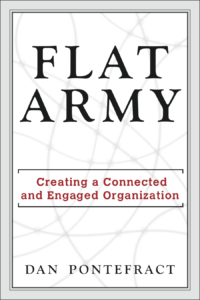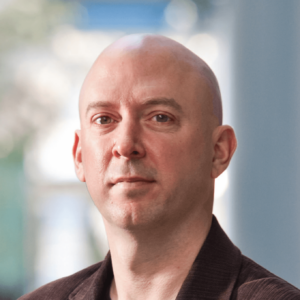(Editor’s Note: We’re thrilled that business collaboration and learning expert, Dan Pontefract, will be a featured guest soon at #TChat events. To set the stage, Dan shares insights below, adapted from his new book Flat Army: Creating a Connected and Engaged Organization.)
Flat Army? What the heck is a Flat Army?
Work environments need not feel like a military camp or a ruthless command-and-control operation. The process of work should be fun, innovative, creative and very engaging. I believe that the best way to create a connected and engaged organization is by invoking a “Flat Army” mindset. Why? Let’s unpack that analogy:
To be flat is to be on a level surface, not in a hierarchy. To be in an army (from armata, the Latin term referenced in 1533, meaning a flotilla of vessels) is to be part of a large group of people who are committed to similar aims or beliefs.
An organization with a Flat Army ethos benefits from an unobstructed flow of coordinated, constructive, creative behaviors that arise from the common interests of employees, leaders, partners and customers. It is a shift from “me” to “we,” using collaborative, participative and growth behaviors. Flat Army is a playbook that moves organizations toward increased engagement and innovation.
Profile Of A Flat Army Leader
 In our Flat Army model, a harmonious, connected leader creates a situation where both the team and the leader are as open as possible to performing business tasks and achieving objectives. In an environment where even mundane day-to-day tasks are conducted in this open manner, there is harmony among all contributors, regardless of rank.
In our Flat Army model, a harmonious, connected leader creates a situation where both the team and the leader are as open as possible to performing business tasks and achieving objectives. In an environment where even mundane day-to-day tasks are conducted in this open manner, there is harmony among all contributors, regardless of rank.
Openness — both as a quality of the leader and an expectation of the team — fosters a harmonious relationship among all parties. It’s arguably a step in the right direction towards higher levels of engagement, productivity and business results. A harmonious, open leader connects with the team — parlaying the culture as if it can only be successful when all parties are united, equal in nature and committed to openness. And if we agree that leadership is for all, we also wish that everyone in an organization will participate as a harmonious, open leader.
Getting Under The Hood With Open Leaders
I define open leadership as the act of engaging others to influence and execute a coordinated and harmonious conclusion. Therefore, open leadership is essential for every Flat Army organization.
A.G. Lafley comes to mind when I think of stellar Flat Army leadership. His name may not ring a bell, but I can assure you, he sets a standard of excellence for openness and collaboration. Between 2000 and 2010, Mr. Lafley was the highly successful president and CEO of Procter & Gamble (P&G) — the consumer products conglomerate with over $80 billion in revenue and over 125,000 employees worldwide.
Throughout his decade at the helm, he helped double total sales and quadruple profits, while increasing P&G’s market value by over $100 billion. Furthermore, he helped grow P&G’s portfolio of billion-dollar brands (such as Gillette, Pampers and Tide) from 10 to 24. How did he do it?
In his book The Game Changer: How Every Leader Can Drive Everyday Innovation, co-written with management thought leader, Ram Charan, Lafley refers to the unique relationship between openness and ideas:
Open architecture is the organizing principle that enables a business and its people to open themselves up to get ideas from anywhere at any time. P&G collaborates with anybody, anywhere, anytime. P&G likes unusual suspects. It will even compete with a company on one side of the street, and cooperate with it on the other. In an open innovation system, anything out there is fair game, even if competitors are sitting on it. And that’s fine with both partners because it works.
At P&G, Lafley opened up everything. He wanted his leaders to be more collaborative, and just as importantly, he wanted his employees to be open. As a results, magic happened. He branded this open architecture “Connect and Develop” or “C&D.” The framework reached across all employees, regardless of title, and it drove not only revenue and profitability, but also employee engagement.
Lafley and Charan explain:
The single characteristic of C&D is the willingness of all people at P&G to be psychologically open and to seriously consider new ideas, whatever the source, thus building a truly open global innovation network that can link up — and be first in line — with the most interesting thinkers and the best products to “reapply with pride.”
Lafley’s leadership example demonstrates what’s possible when a harmonious environment is created through a culture of open initiative. That is Flat Army in action. And perhaps that’s a key reason why P&G just rehired Lafley last month to lead the company forward.
The Open Leader Toolkit
Hopefully now the concept of open leadership is clear. But what are these social business and collaboration tools everyone keeps talking about? An open, Flat Army environment can’t thrive if leaders suffer from technology blindness or ignorance. In truth, tools for communication and collaboration are as integral to a Flat Army mindset as they are to employee engagement and productivity.
If your organization doesn’t embrace tools that support dynamic exchange of knowledge and ideas, then be a catalyst for change. Look for ways to integrate capabilities such as blogging, micro-blogging, expert networks, discussion forums, video sharing or instant messaging into existing platforms and workflows. Start using them to demonstrate that you are a connected, collaborative and participative leader who assists your team (and your organization) in achieving their goals and objectives — even as you strive for a high level of employee engagement and customer satisfaction.
What are you doing to help your organization embrace a Flat Army ethos? I invite you to share your ideas and experiences.
 (Author Profile: Dan Pontefract is the the author of “Flat Army: Creating a Connected and Engaged Organization.” He is also Head of Learning & Collaboration at TELUS where he is responsible for the company’s overarching leadership development, learning and collaboration strategy. Visit www.danpontefract.com for more about Dan’s professional experience, and his thoughts on the future of leadership and organizations.)
(Author Profile: Dan Pontefract is the the author of “Flat Army: Creating a Connected and Engaged Organization.” He is also Head of Learning & Collaboration at TELUS where he is responsible for the company’s overarching leadership development, learning and collaboration strategy. Visit www.danpontefract.com for more about Dan’s professional experience, and his thoughts on the future of leadership and organizations.)
Image Credit: Pixabay
Post Views: 1,115